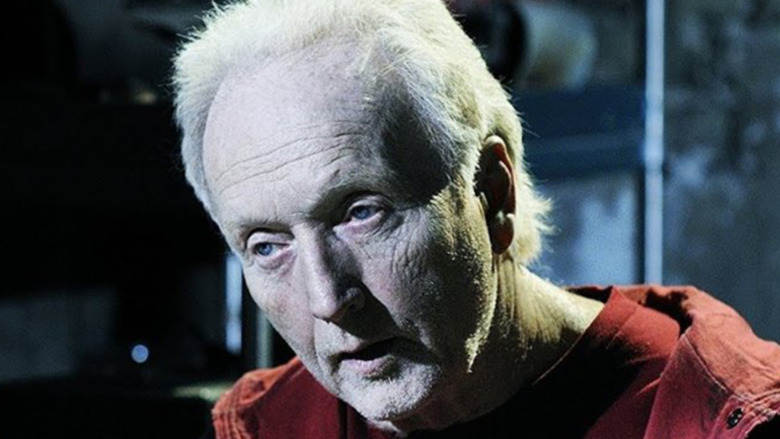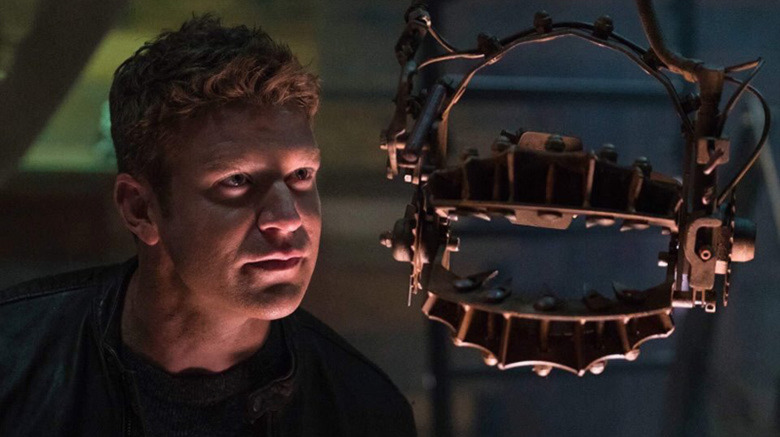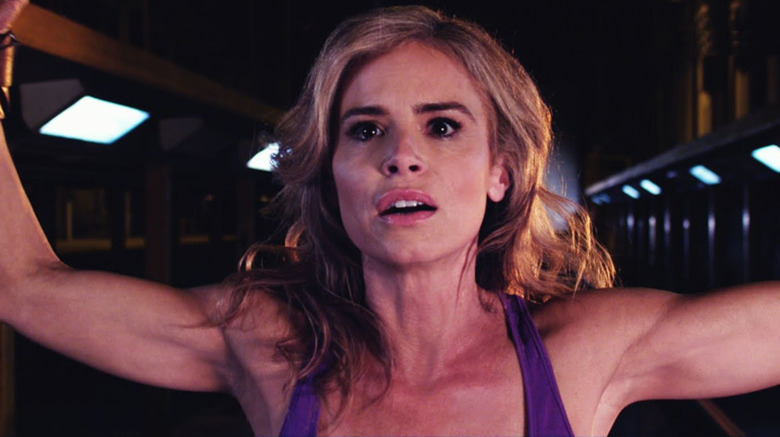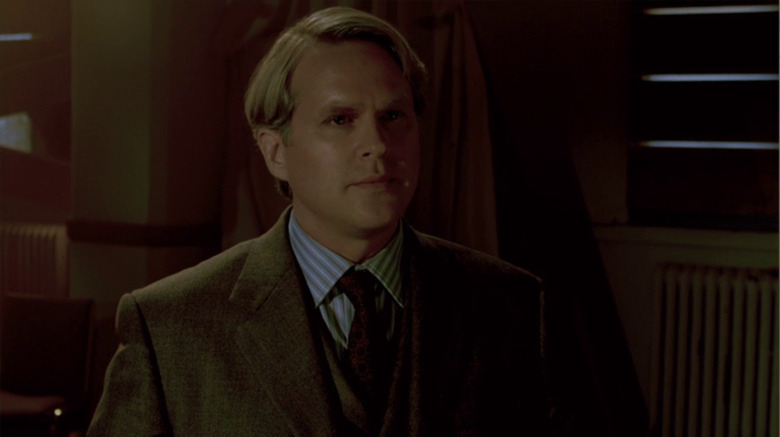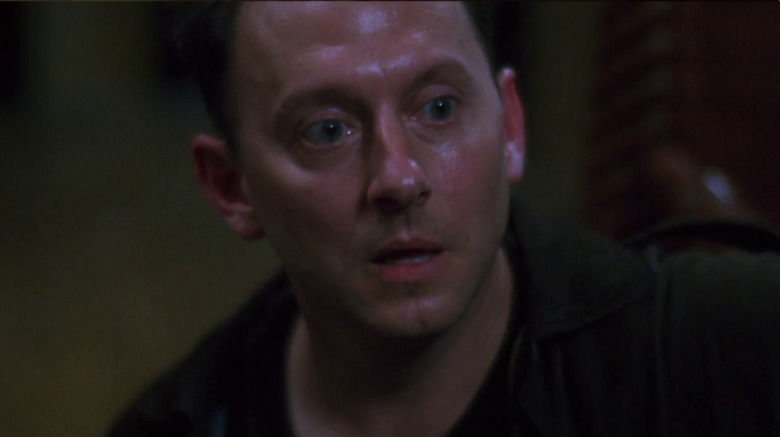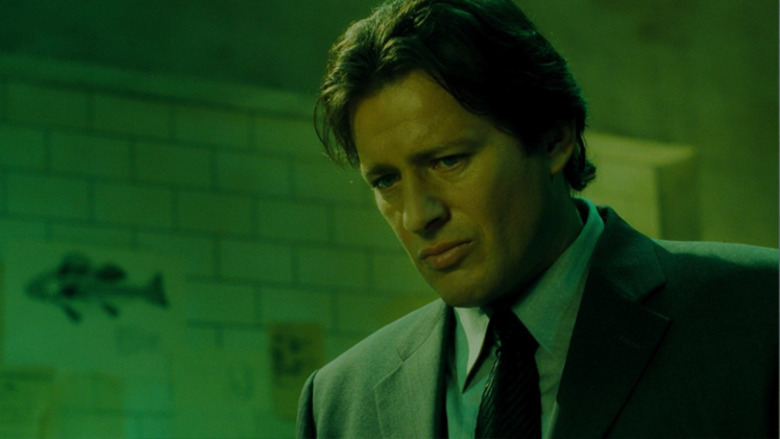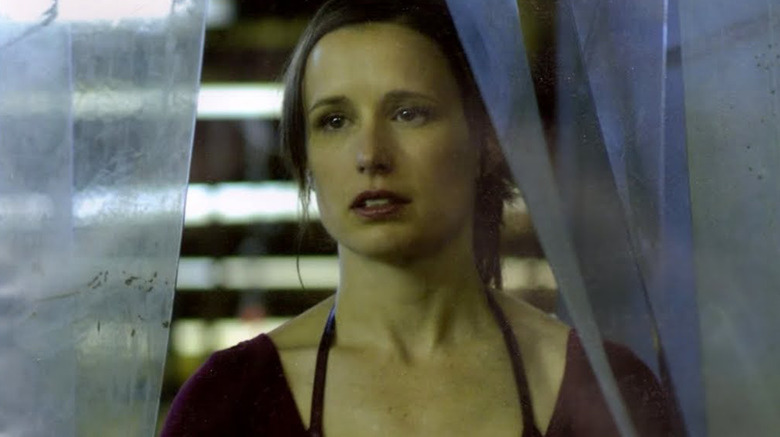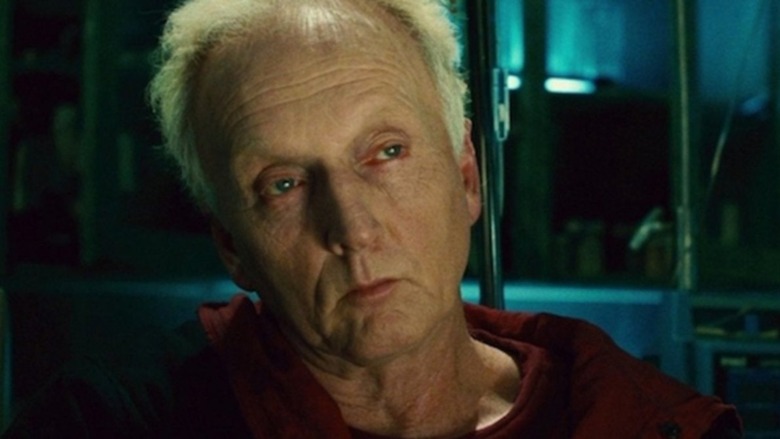Every Saw Villain Ranked Worst To Best
Since its debut in October 2004, Saw has gone on to be recognized as one of the most influential and successful horror films of the age. This inexpensive flick became such a smash hit, in fact, that it grossed nearly 100 times its original budget. Multiple sequels followed, as well as video games, comic books, toys, merchandise, and a theme park ride.
The Saw series' success can be chalked up to two main factors. The first is the increasingly over-the-top sequence of death traps that the series' characters, minor and major, find themselves in. They range from simple traps involving fire and physical mutilation to more complicated devices that incorporate carousels, public store windows, running cars, and the like. This is catnip for gore fans, and ensures the series can always bank on respectable attendance levels come Halloween season.
The second factor is the film's long line of antagonists, who all, in some way, follow in the footsteps of the Jigsaw Killer, the original mastermind behind the series' life-or-death games. Throughout these movies, we see many different villains help carry out the games in various ways. This means that the series has seen many antagonists come and go — which also means that some of Saw's antagonists have been better than others. Which Saw baddies send chills down our spines, and which fail to scare just about anyone? We're here to answer that question by ranking every Saw villain from worst to best.
Logan Nelson (Jigsaw)
Jigsaw is a divisive film within the series. For one thing, it goes in a very different stylistic direction than the previous films do. Its addition to the series is also a point of contention for fans in terms of the series' continuity, which had previously been fairly airtight.
Logan Nelson (Matt Passmore) is presented as a veteran with PTSD, now serving as a police medical examiner and a key suspect throughout the events of Jigsaw. While working at a hospital, Logan accidentally mixes up John Kramer's X-rays with another patient's, which leads to John's cancer going untreated. This error sees Logan placed in the trap that occurs before the events of the first film, where he seemingly dies first. However, he actually survives, and Jigsaw ultimately decides he doesn't deserve to die over an honest mistake. Thus, he makes Logan his original apprentice. Logan is even revealed as the co-creator of the original beartrap device from the first film.
The reason Logan ranks so low is the frankly unnecessary continuity revision his presence forces fans of the series to accept. More so than any other entry in the series, Jigsaw demands you suspend your disbelief so that its status as a pseudo-prequel to the series makes sense. All this really does is overly complicate things in an already rampantly convoluted series.
Jill Tuck (Saw III-VII)
Behind every great man is a woman, and in the case of John Kramer, that woman is his former wife Jill Tuck. Jill (Betsy Russell) stands out as the most innocent person among these antagonists. She doesn't operate out of any sense of vengeance or moral desire, but out of a sense of tying up loose ends.
Jill is formally introduced in Saw IV as a key part of Jigsaw's backstory. Jill and John, we learn, separated after the death of their unborn child, which is what leads John to become the Jigsaw Killer. Jill takes on a more major role in Saw V and Saw VI when she is bequeathed a box as part of John's will. Said box contains a list of the next crop of players, and special instructions which lead Jill to put Mark Hoffman in a more advanced reverse beartrap, which he unfortunately escapes. The tables are turned in Saw VII when Jill is placed in the classic reverse beartrap herself, which leads to her demise.
Jill avoids the bottom rank on this list due to her importance to the plot and the strength of Russell's performance. But she is ultimately not a strong enough antagonist to be ranked any higher.
Dr. Lawrence Gordon (Saw and Saw VII)
Gordon crawls off into the darkness at the conclusion at the first Saw film, leaving hardcore fans with a major question: What the heck happens to him?
Finally, in Saw VII, AKA Saw: The Final Chapter, it is revealed that after escaping the bathroom, Dr. Gordon (Cary Elwes) had his wounds tended to by Jigsaw and was released back into the world. We go on to learn that while Jigsaw was grooming Amanda and Hoffman as tentative successors and inheritors of his legacy, he also kept Dr. Gordon around as an extra set of hands to aid him in his endeavors. Gordon, it turns out, not only assisted with the more medical traps of Saw II and Saw IV, he also helped Jigsaw choose the surgeon who operates on him in Saw III. Most importantly, at the conclusion of Saw VII, Gordon (along with two unknown assailants wearing pig masks) kidnaps Mark Hoffman and proceeds to lock him in the bathroom from the first film, bringing everything full circle.
In his brief time onscreen in Saw VII, Elwes succeeds at being suitably creepy, and even gets to close out the film with an iconic line: "Game over". It's a great twist, but it would have been greater still if only he'd gotten to be a focal point of the film, as opposed to an extended cameo.
Zep Hindle (Saw)
Zep Hindle (Michael Emerson) serves as a creative red herring in the first film. Introduced as a mildly creepy orderly working in Dr. Gordon's hospital, Zep is heavily implied to be the Jigsaw Killer. The movie leads the audience to believe this in multiple ways, including Zep's presence behind the security cameras and the fact that he's the one who holds Dr. Gordon's family hostage while he's trapped in the bathroom with Adam.
Zep meets his end at Adam's hands when the latter man bludgeons him with a toilet tank lid. Adam searches his pockets for some kind of key to escape his shackles, only to find that Zep has his own tape from Jigsaw, and was merely a pawn in a larger game. This, of course, leads to the reveal that the "dead body" present in the bathroom from the film's beginning has been Jigsaw all along.
Zep may only be a red herring, but Emerson brings some genuinely sinister qualities to the role, elevating what would've otherwise been a disposable character. Zep's legacy in the franchise is also long-lasting, despite the character's one-off appearance — soundtrack entries bearing his name, like "Hello Zepp," pop up during later Saw films' most climactic moments.
Mark Hoffman (Saw III-Saw VII)
Mark Hoffman (Costas Mandylor) is first introduced as a cop assigned to the Jigsaw investigation in Saw III. He is later revealed to be Jigsaw's apprentice. Mentally broken by the murder of his sister, Hoffman engineers his own Jigsaw-style deathtrap for the perpetrator: Saw V's famous guillotine trap. Given his status as a police officer, he is able to throw everyone off his scent.
Everyone, that is, except John Kramer, who doesn't take kindly to someone jacking his style — especially in a way he deems to be inappropriate. Say what you will about John Kramer as a person, but at least he gives his victims a way to win. Hoffman didn't, and that is what leads John to take action. From that point on, Hoffman is basically blackmailed into helping John with his work, serving as the main antagonist from Saw IV to Saw VII. Hoffman's presence is a point of contention for Amanda, which leads to Hoffman blackmailing her. This results in her end in Saw III.
While Hoffman's presence in the series adds a nice dose of unpredictability, he himself is not very interesting, especially when compared to Amanda Young or John Kramer. Regardless, he still earns a solid spot in the rankings for giving the latter half of the original Saw series a clear focal point.
Amanda Young (Saw-Saw III)
Introduced as a victim in the original Saw, Amanda (Shawnee Smith) is a former drug addict. After she becomes one of the only people to ever survive a Jigsaw trap, John recruits her to help him carry out his work.
The key difference between the two is that Amanda doesn't see giving people a fair chance as necessary to the games. In fact, she often injects her own agenda into her creations, rendering her traps unwinnable — a definite no-no in John's eyes. During the events of Saw III, John engineers things to give Amanda one final chance to do things the "right" way. But due to what is eventually revealed to be Mark Hoffman's meddling, Amanda opts to act impulsively. This leads to the demise of Dr. Lynn Denlon, Amanda herself, and, inadvertently, John.
It's very clear that Amanda wants to follow John's teachings to the letter, but her own demons and inability to separate herself emotionally from her work is what ultimately leads to her downfall. Smith brings a mesmerizing blend of hostility and zealous psychosis to the role. She is ready, willing, and able to turn on the crazy at any given moment, especially in Saw III. Additionally, Smith and Tobin Bell share genuinely charming chemistry, in a twisted father-daughter kind of way. It is legitimately sad to see her bleed to death in front of John as he laments the fact that she couldn't pass his test.
John Kramer, AKA Jigsaw (Saw-Jigsaw)
John Kramer (Tobin Bell) has one of modern horror's most compelling backstories. After enduring tragedy and illness, he becomes so detached from the world that he dedicates the rest of his life to making sure people cherish their lives ... through the most heinous possible means. The morbidly ironic traps and games he devises for his "players” usually cause them to mutilate themselves or others for the sake of long-term survival. They are the series' trademark, and the manifestation of John's twisted ethos.
When compared to the likes of Freddy Krueger or Jason Voorhees, John especially stands out: He definitively dies in Saw III, yet still manages to be present and active in the series. Though other villains might have become boring after a while, Jigsaw remains an interesting antagonist — especially since, technically speaking, he never actually kills anyone. Sure, he puts people in horrific scenarios, but he always offers at least one logical, albeit awful, way to survive and escape. When someone unfairly dies in a game, it's often due to either Amanda or Mark not wanting to give people a fair chance like John does.
Tobin Bell brings a sense of legitimacy and class to what would have otherwise been a disposable series of torture-focused horror films. His subtly powerful performance has made the Jigsaw Killer one of horror's most memorable villains, and Saw one of the genre's most memorable franchises.
